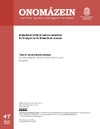Please use this identifier to cite or link to this item:
https://accedacris.ulpgc.es/handle/10553/72448
| DC Field | Value | Language |
|---|---|---|
| dc.contributor.author | Cáceres Lorenzo, M. Teresa | en_US |
| dc.date.accessioned | 2020-05-14T18:27:53Z | - |
| dc.date.available | 2020-05-14T18:27:53Z | - |
| dc.date.issued | 2020 | en_US |
| dc.identifier.issn | 0718-5758 | en_US |
| dc.identifier.other | Scopus | - |
| dc.identifier.uri | https://accedacris.ulpgc.es/handle/10553/72448 | - |
| dc.description.abstract | The lexicon that coincides with the geographic region formed by the six countries of the American isthmus has not yet been examined as part of a single dialectical area. Our inquiry proposes to analyse and classify the lexical units that are recorded in dialectical dictionaries as a means to answer the question of whether this is a single dialectical area. Through a quantitative and qualitative methodology, we discover that the Central American territory presents two groups according to lexical repertoire. The results demonstrate that the first includes El Salvador, Guatemala, Honduras and Nicaragua, which have a greater number of coinciding words compared to Costa Rica and Panama. Data about the indicators that shed light on etymological origin and lexical-semantic creation, adoption and adaptation to understand the trends followed by each group are also provided. This work contributes to the possibility of considering Central America as a dialectical unit. | en_US |
| dc.language | eng | en_US |
| dc.relation.ispartof | Onomazein | en_US |
| dc.source | Onomazein [ISSN 0717-1285], n. 47, p. 158-177, (Marzo 2020) | en_US |
| dc.subject | 5701 Lingüística aplicada | en_US |
| dc.subject.other | Central America | en_US |
| dc.subject.other | Dialectical Lexicon | en_US |
| dc.subject.other | Dictionary Of Americanisms | en_US |
| dc.subject.other | Dictionary Of Spanish In Panama | en_US |
| dc.title | Dialectical Unity in Central America? An Analysis of its Dialectical Lexicon | en_US |
| dc.type | info:eu-repo/semantics/article | en_US |
| dc.type | Article | en_US |
| dc.identifier.doi | 10.7764/onomazein.47.07 | en_US |
| dc.identifier.scopus | 85109565336 | - |
| dc.contributor.orcid | 0000-0002-1683-9025 | - |
| dc.contributor.authorscopusid | 18036395700 | - |
| dc.identifier.eissn | 0718-5758 | - |
| dc.description.lastpage | 177 | en_US |
| dc.identifier.issue | 47 | - |
| dc.description.firstpage | 158 | en_US |
| dc.investigacion | Artes y Humanidades | en_US |
| dc.type2 | Artículo | en_US |
| dc.description.numberofpages | 20 | en_US |
| dc.utils.revision | Sí | en_US |
| dc.date.coverdate | Marzo 2020 | en_US |
| dc.identifier.ulpgc | Sí | en_US |
| dc.description.sjr | 0,244 | |
| dc.description.jcr | 0,419 | |
| dc.description.sjrq | Q2 | |
| dc.description.jcrq | Q4 | |
| dc.description.ahci | AHCI | |
| dc.description.ssci | SSCI | |
| item.grantfulltext | open | - |
| item.fulltext | Con texto completo | - |
| crisitem.author.dept | GIR IATEXT: División de Estudios de Corpus y Lingüística Aplicada | - |
| crisitem.author.dept | IU de Análisis y Aplicaciones Textuales | - |
| crisitem.author.dept | Departamento de Filología Hispánica, Clásica y de Estudios Árabes y Orientales | - |
| crisitem.author.orcid | 0000-0002-1683-9025 | - |
| crisitem.author.parentorg | IU de Análisis y Aplicaciones Textuales | - |
| crisitem.author.fullName | Cáceres Lorenzo, M. Teresa | - |
| Appears in Collections: | Artículos | |
SCOPUSTM
Citations
2
checked on Jun 8, 2025
WEB OF SCIENCETM
Citations
1
checked on Jun 8, 2025
Page view(s)
182
checked on Mar 1, 2025
Download(s)
280
checked on Mar 1, 2025
Google ScholarTM
Check
Altmetric
Share
Export metadata
Items in accedaCRIS are protected by copyright, with all rights reserved, unless otherwise indicated.
